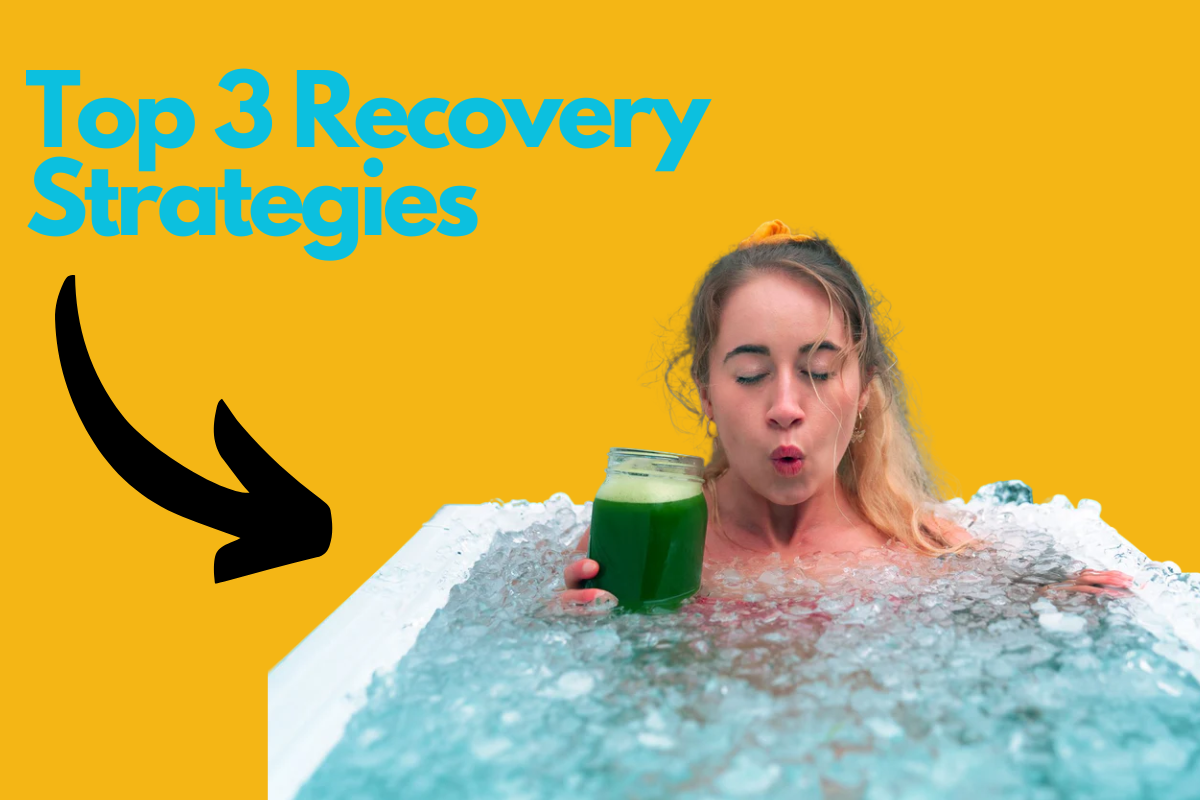
Recovery Strategies After A Long Run
Imagine crossing the finish line of a half-marathon — the sense of accomplishment, the exhaustion, and the aching muscles.
You’ve pushed your body to the limit, and now recovery is everything. But how do you recover in the best possible way? Should you jog it out, soak in cold water, or get a massage?
That’s exactly what this article answers.
We’re discussing the study By Wiewelhove and colleagues, which looks into the effects of different recovery interventions on fatigue markers in trained long-distance runners.
The study focuses on three popular strategies:
- Active recovery
- Cold water immersion
- Massage
And trust me, the results might surprise you.
Whether you’re a physiotherapist guiding your patients or a runner eager to optimise recovery, understanding the science behind these methods is critical.
This article takes the heavy lifting out of research — we simplify the key findings so you can apply them in practice.
Ready to up your recovery game?
In A Nutshell
Rapid Results:
- Cold Water Immersion is effective for reducing muscle soreness and perceived stress post-race, though it may impair muscle performance in the short term.
- Massage helps alleviate muscle soreness and improve perceived recovery but has little impact on objective fatigue markers like muscle damage or inflammation.
- Active Cool-Down, specifically running-based, is not recommended as it may worsen recovery and delay muscle regeneration after prolonged endurance exercise (cycling and swimming may be okay)
Professional Takeaway:
Tailor recovery strategies like massage, cold, active recovery, passive recovery and even stretching to the runner’s preferences, logistics, and event conditions. There is no size that fits all, thus listen to your patients.
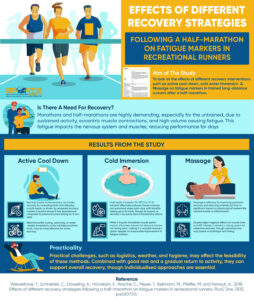
Aim Of The Study
The aim of the study is to look at the effects of different recovery interventions such as:
- Active Cool-Down
- Cold Water Immersion
- Massage
On fatigue markers in trained long-distance runners after a half-marathon.
Specifically, the study outlines how these recovery strategies impact various aspects of fatigue, such as muscle soreness, muscle contractile capacity, perceived recovery and stress, as well as blood markers related to muscle damage (e.g., creatine kinase), inflammation (e.g., C-reactive protein), and metabolic and neurohumoral regulation.
The researchers aim to assess which of these recovery methods is most effective in improving recovery and reducing fatigue markers after endurance exercise.
Did You Know?
The combination of a sustained activity, eccentric muscle contractions, and high intensity, resulting in significant fatigue make marathons and half-marathons extremely demanding (ESPECIALLY if a person is untrained).
This fatigue affects both the central nervous system and skeletal muscles, resulting in decreased muscle performance that can last several days. Hence the need for recovery strategies that help return runners back on the tracks 🌲🏃♀️
They also help increase the general well-being, reduce the time it takes to return to training, and reduce the risk of injury or illness
Recovery Strategies & Their Role
To make it plain and simple, their aim is to reduce muscle fatigue and accelerate the return.
- Active Recovery – Light aerobic exercises like cycling, swimming, or slow running, intended to increase blood flow and clear metabolic byproducts.
- Cold Water Immersion – Using cold water to reduce muscle inflammation and soreness.
- Massage – To reduce muscle tightness and enhance circulation.
These methods are widely popular but need a good look from a scientific perspective. And if you have been here long enough, you know that this is exactly what we love to do.
What Does The Current Research Say?
Research specifically focused on marathon-induced fatigue recovery is limited, and most studies simulate fatigue with non-functional exercises (I.e the treadmill). Which leaves one very importnat questions…
Whats the applicability to road running?
- Cold Water Immersion: A study by Wilson et al. found no significant recovery benefits compared to a placebo, which questions its use in road running.
- Massage: Research by Dawson et al. reported no physiological or pain relief benefits after a half-marathon.
- Active Recovery: Sherman et al. noted that active recovery did not restore muscle function more effectively than passive recovery over a week post-marathon.
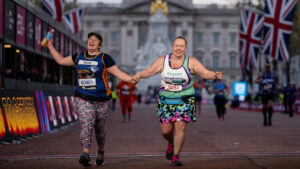
Methods Of The Study
Study Design:
- The study recruited 46 healthy male recreational runners from a competitive half-marathon.
- All participants completed the Physical Activity Readiness Questionnaire to rule out contraindications to vigorous exercise.
Recovery Protocols:
- Passive Recovery: Seated rest for 15 minutes.
- Active Recovery: Sub-maximal jogging for 15 minutes at 60% of their anaerobic threshold.
- Cold Water Immersion: Immersion of legs in 15°C water for 15 minutes, with periodic leg movement to prevent thermal boundary layers ←This I LOVE
- Massage : A 20-minute sports massage using structured techniques like effleurage, petrissage, and friction, targeting specific leg muscles in prone and supine positions.
Participant:
- Participants were matched into quartets based on age and anaerobic threshold.
- Random assignment within quartets ensured balanced groups for each recovery protocol.
- Baseline physical and performance characteristics were comparable across groups
Performance & Recovery Measurements:
- Physical Performance: Countermovement jump height measured before and after interventions and 24 hours post-race.
- Muscle Function: Tensiomyography assessed the contractile properties of the rectus femoris muscle, focusing on muscle tone and contraction time .
- Biochemical Markers: Blood tests measured creatine kinase, c-reactive protein, urea, insulin-like growth factor-1, and free testosterone to evaluate muscle damage, inflammation, and recovery.
- Subjective Measures: Muscle soreness assessed via a visual analog scale and perceived recovery/stress states evaluated using the Short Recovery and Stress Scale.
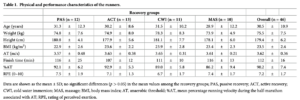
Controlled Variables
- Participants followed a standardised diet and avoided supplements, caffeine, and alcohol from one week pre-race to the end of testing.
- Consistent post-race nutrition was provided (bananas, cereal bars, water) to ensure uniformity in recovery conditions.
Experimental Setup
- An incremental field test determined aerobic treshold one week before the race, guiding exercise intensity for recovery protocols.
- Blood samples and counter movement jump performance data were collected at multiple time points: 24 hours pre-race, post-recovery intervention, and 24 hours post-race.
Competitive Race Details
- The race involved a 450m altitude climb, with average finish times ranging from 107 to 116 minutes across groups.
- Participants’ perceived effort was rated between 6.7 and 7.5 on a scale, reflecting the challenging nature of the race.
Results
Okay, let’s sum this up! The exact data are in the images below 🤓
Fatigue:
As you would thing running a half-marathon triggers significant fatigue, shown by changes in
- Muscle contractile function
- Soreness
- Stress
- Blood markers like creatine kinase (muscle damage), c-reactive protein (inflammation), and neurohumoral factors like free testosterone
These shifts occur regardless of recovery strategy.
Active Recovery
Active recovery, especially running-based cool-downs, can backfire.
This study found it worsened perceived recovery and markers like creatine kinase and free testosterone compared to passive recovery.
Running-based active recovery likely adds strain due to eccentric loading, delaying muscle repair.
👇👇👇
However, cycling, swimming, or water-based movements, which reduce eccentric strain, might be better alternatives for athletes who prefer active recovery. While some studies show benefits of active recovery, Its important to consider what this active recovery entails.

Cold Water Immersion:
Cold water immersion showed promise in reducing muscle soreness and perceived stress both immediately and 24 hours post-race.
However, it impaired immediate muscle performance, likely due to cold-induced nerve conduction and muscle temperature changes.
Despite this, the performance impact is less relevant for distance runners who aren’t racing again soon.
The optimal protocol = (11–15°C for 11–15 minutes) .
Keep in mind, Cold water immersion effects can vary depending on exercise type and specific protocols.
Cold water immersion is often praised for reducing muscle soreness and stress post-exercise. Its pain relieving effects are partly linked to activating TRPM8 receptors, which modulate pain perception through neural pathways.
Interestingly, this study found that cold reduced muscle soreness even 24 hours after a half-marathon.
However, whether this is due to physiological mechanisms or a placebo effect is unclear. The runners’ expectations of Cold water immersion benefits may have influenced their perceptions.
Supporting this, prior research found Cold water immersion no more effective than placebo immersion in improving recovery.
Despite no measurable impact on objective fatigue markers, its perceived benefits might still make it a very valuable option to consider.
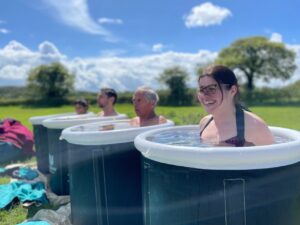
Massage:
Massage stood out for improving perceived recovery and reducing soreness over the short and medium term.
However, it had no positive effects on objective markers like creatine kinase (muscle damage) or inflammation and slightly impaired muscle tone and IGF-1 levels.
Still, for subjective recovery, it’s a strong option.
Massage showed consistent benefits in reducing muscle soreness and enhancing perceived recovery. However, like cold immersion, its effects were limited to subjective measures; it did not significantly impact physiological markers like creatine kinase or IGF-1.
In fact, massage showed a slight negative effect on certain markers, such as muscle stiffness and IGF-1 levels, though the reasons remain unclear.
These inconsistencies could stem from variations in massage techniques, therapist skills, and timing.
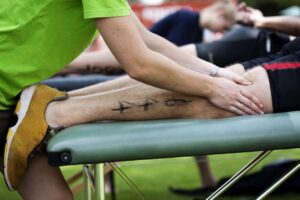
Limitations of the study:
The placebo effect likely influenced both Cold water immersion and massage results, given the challenges in blinding participants and the perceptual nature of muscle soreness assessments.
Additionally, limitations like the lack of a crossover design, few measurement points, and the absence of treatment belief measures might have skewed findings. Future research should integrate better placebo controls and refine methodologies to clarify the true effects of these recovery strategies
The Main Takeaway
**From This Specific Study**
After a half-marathon, recovery is critical for runners to reduce physical & psychological stress, no matter if the person is a seasoned athlete or just trying cross out a wish from the bucket list.
It’s pretty clear that running-based active cool-downs, despite their popularity, can actually worsen recovery outcomes.
So, it’s probably best to skip the post-race jog and focus on strategies like cold water immersion and massage, which help runners feel better by reducing muscle soreness and perceived stress.
These methods don’t necessarily fix the underlying physical fatigue or damage but can significantly improve the psychological sense of recovery. This feel-good factor can increase confidence and mental readiness for future runs, which is super valuable since pain and stress alone can negatively affect performance, even when the body is physically capable.
That said, perceptual recovery doesn’t always align with physiological recovery.
For instance, cold water immersion may make runners feel ready to do another workout, but it doesn’t repair muscle damage or restore immune function after a race.
This “immune dysfunction window” post-race leaves the body vulnerable to infections. Jumping back into intense training based on subjective recovery alone could lead to
- Overtraining
- Heightened fatigue
- Injuries
Practicality also matters. Cold water immersion is great in warm climates but less appealing in cold, wet weather. Hygiene and logistics during events can be challenging too—finding clean facilities or booking a massage takes planning.
Plus, this study only looked at single-use recovery methods, which might not be enough. Future research could look at whether repeated or prolonged applications of these techniques work better.
Ultimately, the choice of recovery strategy should consider individual preferences, available resources, and the potential for long-term benefits.
Even without perfect evidence, cold water immersion and massage are solid options for feeling better post-race, as long as they’re combined with sufficient rest and gradual return to activity.
Clinical Tips
Prioritise Recovery Over Cool-Down Runs:
Advise runners to skip running-based active cool-downs after a race, as they can worsen muscle damage and fatigue due to sustained eccentric strain. Instead, suggest low-impact alternatives like cycling or walking to promote recovery without additional strain.
Incorporate cold (if it makes sense):
You can recommend cold water immersion (11°C–15°C for 11–15 minutes) to reduce muscle soreness and reduce stress perception, especially after races in hot weather. However, explain that while it helps runners feel better, it does not directly repair muscle damage or improve performance markers.
Educate on Perceptual vs. Physiological Recovery:
Make runners aware that improved perception of recovery (e.g., reduced soreness or stress) doesn’t always align with true physical restoration. For instance, a runner may feel ready to train but still have underlying muscle or immune dysfunction, which could lead to overtraining or illness.
Individualised Recovery:
Tailor recovery strategies like massage, cold, active recovery, passive recover and even stretching to the runner’s preferences, logistics, and event conditions. There is no size that fits all, thus listen to your patients.
Gradual Return to Activity:
Encourage runners to take sufficient rest (2-3 days) and reintroduce training slowly, using sports like swimming or cycling to stay active without overloading fatigued muscles. Highlighting the importance of this to prevent injuries or immune issues such as upper respiratory tract infections can go a long way.
References:
- Dawson, L.G., Dawson, K.A. and Tiidus, P.M., 2004. Evaluating the influence of massage on leg strength, swelling, and pain following a half-marathon. Journal of sports science & medicine, 3(YISI 1), p.37.
- Ihsan, M., Watson, G. and Abbiss, C.R., 2016. What are the physiological mechanisms for post-exercise cold water immersion in the recovery from prolonged endurance and intermittent exercise?. Sports Medicine, 46, pp.1095-1109.
- Sherman, W.M., Armstrong, L.E., Murray, T.M., Hagerman, F.C., Costill, D.L., Staron, R.C. and Ivy, J.L., 1984. Effect of a 42.2-km footrace and subsequent rest or exercise on muscular strength and work capacity. Journal of Applied Physiology, 57(6), pp.1668-1673.
- Wiewelhove, T., Schneider, C., Döweling, A., Hanakam, F., Rasche, C., Meyer, T., Kellmann, M., Pfeiffer, M. and Ferrauti, A., 2018. Effects of different recovery strategies following a half-marathon on fatigue markers in recreational runners. PLoS One, 13(11), p.e0207313.
- Wilson, L.J., Cockburn, E., Paice, K., Sinclair, S., Faki, T., Hills, F.A., Gondek, M.B., Wood, A. and Dimitriou, L., 2018. Recovery following a marathon: a comparison of cold water immersion, whole body cryotherapy and a placebo control. European journal of applied physiology, 118, pp.153-163.



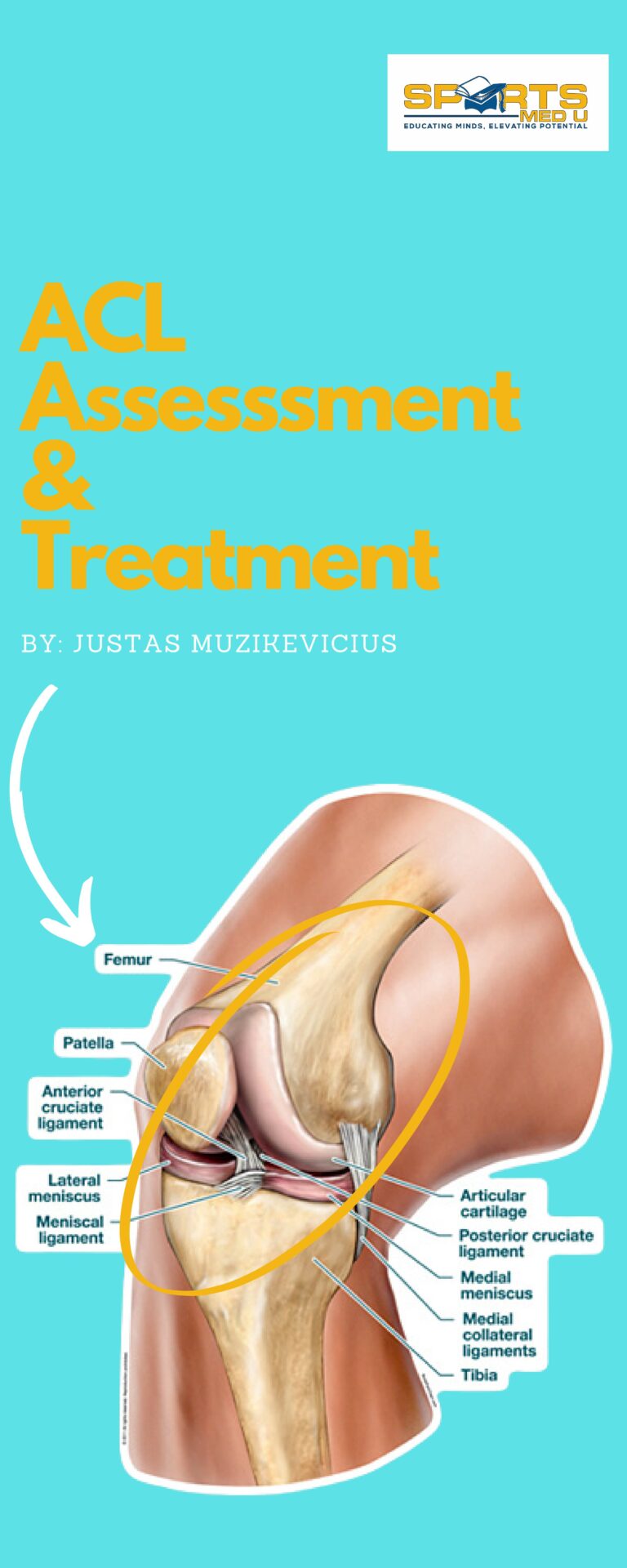



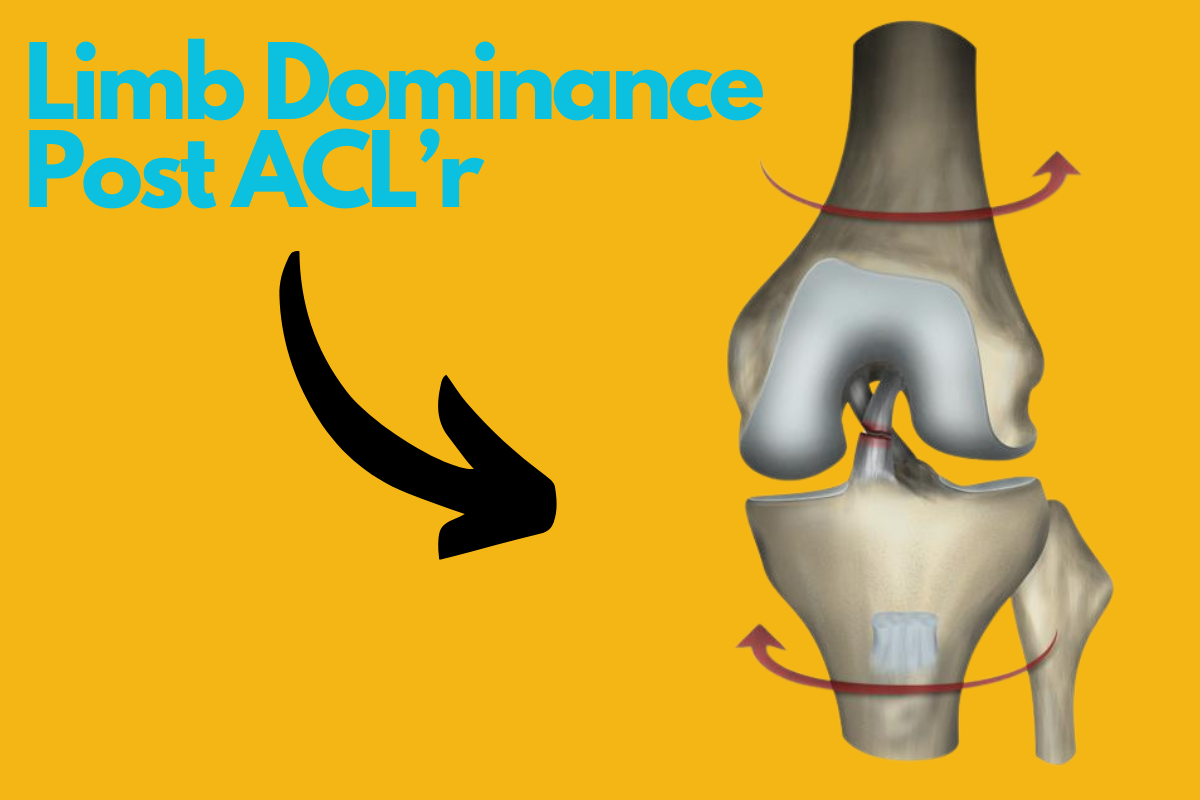
Leave a Reply